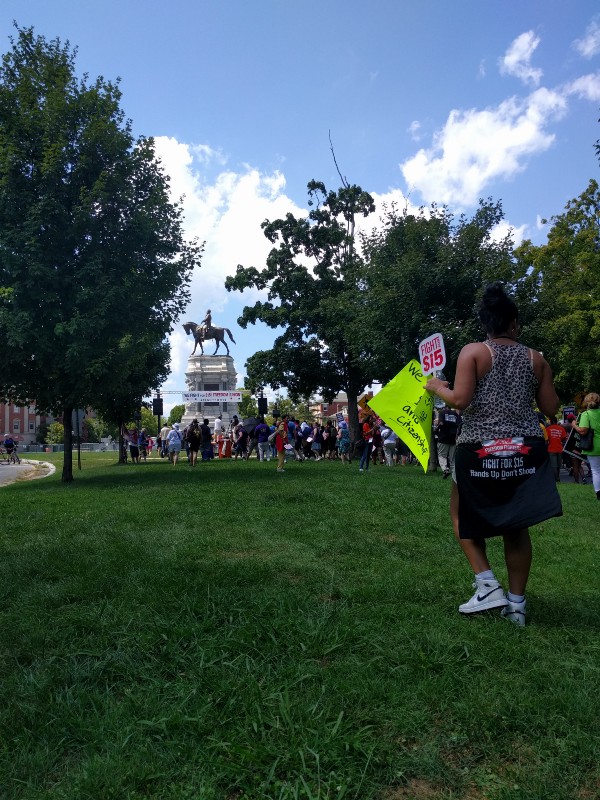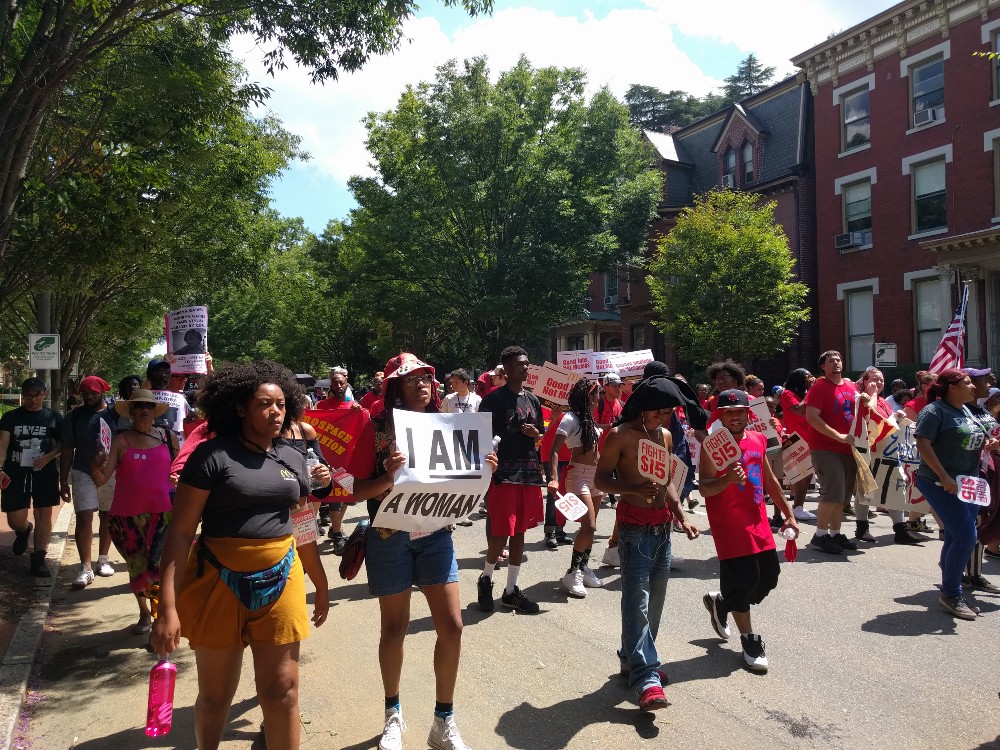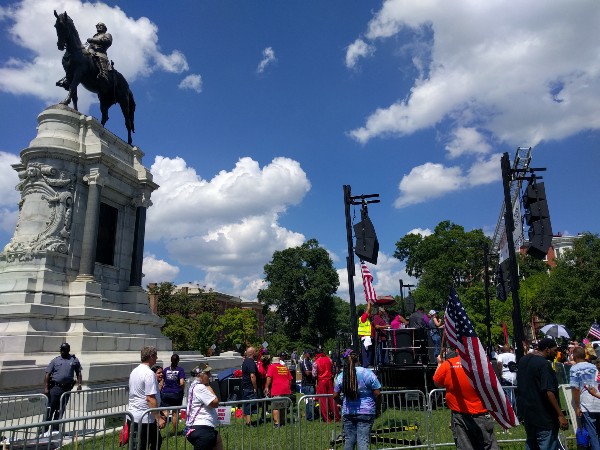RICHMOND, Virginia — Mercury put the temperature at 96 degrees, but the heat index read 109 on Saturday as more than 1,000 low-wage workers marched, chanted, and danced their way from Monroe Park to the base of a 60-foot-high, 126-year-old statue of Gen. Robert E. Lee.
The Fight for $15 had reached the capital of the old Confederacy, determined to link modern economic exploitation to the system of free, forced labor that built the United States.
The populist workers’ movement that spread from New York City to over 300 towns across the country in just a few years and won large wage hikes from lawmakers in more than a dozen states isn’t content. It’s ready to expand its reach and broaden its aims beyond the nickel-and-dime concerns that sparked it. And it’s ready to link corporate policies on wages to the ugliest part of American history.
“If you follow the James River from this city down to the sea you will find the place where my African-American ancestors first set foot on these shores,” Rev. William Barber told the crowd. “My African-American ancestors were brought here to work the land, to build this nation, but they were paid nothing for their labor.”
The vast majority of the workers marching in Saturday’s heat to hear Barber speak were black, too. The modern mass movement for living wages and union rights may be a rainbow coalition backed by traditional union powers, but the energy pervading the march to Lee’s monument was palpably modern and unapologetically black.
“Your wages way too low, you need to hike it,” one cluster of marchers sang to the patter of O.T. Genasis’ drug-rap hit “Cut It.” A couple of young kids bopped under twirling umbrellas like members of a second-line parade in New Orleans. As the group passed a line of unsmiling Richmond police officers, the chanters switched into a different wage chant based on Chedda da Connect’s “Flicka Da Wrist.” The cops jumped on their bicycles to head further up the route.
“What good is it if I won $15 and a union but I still get off work and get shot by a cop in the street?”
Law enforcement was ever-present but lightly geared, with officers from three different agencies holding the edges of the protest route and manning a barricade to keep people away from the statue of Lee. The only times cops rushed through Saturday’s crowd were when someone had succumbed to the heat. Thirty-five people were treated for heat stroke and related illnesses in about an hour, a city police spokeswoman told ThinkProgress.
Almost 100 times that many turned up for the Fight for $15 national convention, organizers said. They didn’t come solely to celebrate a string of state and local legislative victories that have rapidly reset the politics surrounding corporations that pay so little that hardworking people still rely on public assistance. They were here to reach further, challenging the interlocked systems of housing discrimination, police violence, educational inequality, and social segregation that have defined life in black America ever since the Confederate States of America acknowledged it had lost, and Richmond became just another state capital.
“What good is it if I won $15 and a union but I still get off work and get shot by a cop in the street?” Fight for $15 national organizing committee member Terrance Wise said in an interview. “You can’t only fight for economic justice, you have to have racial and economic justice on the same playing field.”
Eyes Wide, Arms Wider
As thousands of workers arrived to the Richmond convention hall Friday night, organizers took the stage to lead a raucous roll call. People screamed and leapt onto tables as each state and union chapter present got recognized. The fast food workers who launched the movement welcomed newer industries: childcare providers, home-care workers, manicurists, and even academics.
Tara Holman is an adjunct philosophy professor at Spelman, a renowned historically black women’s college in Atlanta. In 17 years teaching college courses, she’s changed jobs at least 10 times. She earns a flat rate — around $2,500 per course per semester — no matter how many hours she puts into the work, with no guarantee of being kept on the next term.
“It’s definitely not what I pictured when I went into this field. I had no idea there were professors out there waiting tables to make ends meet or working at retail stores,” Holman said as the crowd thundered on Friday night. “It would be the best job in the world if I actually made a sustainable, living wage.”
Instead, despite 10- and 12-hour days and long weekends grading papers, Holman said she has had to rely on food stamps and help from her parents to support herself and her 12-year-old son Malik, a computer whiz who would be a natural fit for coding camps if he came from a family that could afford them.

For Tolanda Barnette, working 35 and 40 hour weeks in a childcare center is a dream job. But the personal rewards are a poor substitute for financial ones. She makes $10 an hour after about 14 years in the field. And until two days before we met, she and her three kids had been homeless for more than two years.
Even with the move, Barnette is far from the stability a full-time job ought to provide. Her oldest son should be starting at Morehouse this fall, but the family is struggling to come up with the money to get him enrolled at Martin Luther King, Jr’s alma mater.
It’s the latest indignity in a years-long string of struggles. Like Holman, Barnette is tired of working so hard for so long with so little to show for it.
“We want to live,” Barnette said, as a speaker behind us reminded the crowd that women like Barnette have been looking after white children with hardly any reward and even less cultural recognition since centuries before Jefferson Davis declared Richmond the capital of a new nation willing to fight to preserve slavery. “We’re tired of surviving.”
Local, Sustainable, Organic Anti-Racism
Pundits describe the 2016 presidential election in terms of competing populist movements, and television coverage gravitates toward Donald Trump’s vulgar and violent crowds. But the Black Lives Matter movement and its natural Fight for $15 allies and the giant rallies against anti-transgender bigotry in North Carolina are where the action is for street-level mass movements.
Organizers hope to braid those movements into a rope that can pull this election season toward progress. The working poor who are fueling this shoeleather activism aren’t necessarily focused on the White House, Service Employees International Union president Mary Kay Henry told ThinkProgress in Richmond. “For us, the local races are the way in,” she said, “and then we take people up to the presidency.”
“People said $15 was impossible, that’s starting to happen. Why not end racism?”
“Workers wage increases haven’t happened through the president. They’ve happened through their city council member, their state legislator, the governor in their state,” Henry added. “There’s a despair that this movement is addressing about, ‘How does electing somebody actually change my life?’”
A presidential candidate’s allies often try to lengthen the coattails of a national win by promoting favored local candidates among supporters of the person atop the ticket. The Fight for $15’s electoral work is operating in reverse, she said, with local wins rejuvenating faith that elections matter in the first place.
“People have hope and confidence because hey, wages are going up, and if I stay active and continue to get engaged, turn out and vote, stay in the streets, who knows what will happen?” she said.
“People said $15 was impossible, that’s starting to happen. So why not a union? Why not end racism? Why not every immigrant become a citizen?”
The movement’s local focus has won a wave of new benefits for workers, not just on wages but on paid leave for illness or raising a new child. In some cases, those wins got quickly trampled by so-called pre-emption laws passed by Republican statehouse majorities.
“We won a minimum wage increase in Kansas City just last summer, nearly doubled the minimum wage at the city level, only to have rich white Republicans in Jefferson City pass legislation to turn it down,” said Wise. “You’ve got to see it for what it is: Pure racism.”

Since 2013, 11 states have passed a law barring localities from setting a higher minimum wage than the state’s. A dozen have tried to override local paid leave laws in that time. Henry’s union and Barber’s organization Repairers of the Breach have fought such pre-emption laws in court.
In trying to override worker victories, state lawmakers poked a bear. According to workers, organizers, and staffers in Richmond, pre-emption laws — essentially, the legislative revenge of the powerful — sparked the idea of using this summer’s convention to connect modern wage serfdom to the confederacy’s desperate lunge at preserving slavery.
A Monument To Division And Revenge
Erected in 1890 in the middle of a traffic circle, the giant horse-mounted figure of the Confederacy’s top military commander is the spiritual center of Richmond. Workers chose it as Saturday’s focal point because Lee is a human symbol of how far powerful Americans have been willing to go to retain power.
But Lee’s statue — defiantly thrown up barely a generation on from the general’s surrender, the South’s defeat, and the Emancipation Proclamation — is perhaps an even better illustration of what the fight for decent wages and union rights is truly up against.
“We can’t wait another 400 years.”
By the time Richmond’s city fathers first started raising money to hoist Lee high above Monument Avenue, rich southern whites had already laid violent waste to the post-war dreams of black liberation and political solidarity between freed slaves and poor whites. It took less than a decade for Reconstruction to give way to what landowners below the Mason-Dixon called Redemption — something Barber sternly reminded a meeting a fellow clergymen and women that morning ahead of the march.
“In the first 10 years after slavery, black and white people came together in the south in a fundamental shift. In 1868, 69 and 70 they were talking about increasing wages,” he said that morning. “It got so powerful that the former slave owners couldn’t stand it. So they came up with a movement called the Redemption movement…because they were too afraid that blacks and poor whites would build economic, educational, and voting power together which they were doing.”
“And the theme of it,” he added, “was ‘We gotta make America great again.’”



The Lee monument marks the rapid success of the white establishment’s dismantling of Reconstruction. The landmark victories of the Civil Rights Movement endured longer but faced the same sort of immediate and tenacious backlash. Establishment whites who preferred the status quo slowly chipped away at voting rights, let school desegregation efforts languish, and built housing blocks that isolated and slowly poisoned the poor, mostly black Americans who lived in them.
“We want to live. We’re tired of surviving.”
Nationally, the overt racism of Nixon gave way to the dog whistles of Reagan. But the strategy — pit poor whites against poor blacks to control the south, use the south to control the nation — remains consistent even today, Barber told the crowd at Lee’s stone feet.
“When the greedy attempt to buy elections thru money and hostile takeovers, and legislatures are caught red-handed passing racist and discriminatory voting laws to suppress the vote and undermine the political power of black, brown and white political coalitions in the south,” he said, “we’ve got to raise up now.”
This is not a crowd that needs to be exhorted to action. These workers have been striking, marching, risking arrest, and organizing their colleagues for years now. They know the score. But Barber reminded them of the urgency of their cause, and made clear that this movement will not be content to rely on charts and back-room meetings and the polite, self-effacing mode of political argument.
“Slavery was about free work. It was about wages,” Barber said. “Why we’re here today is to say look, in the South, it took 400 years from slavery to now to get from zero to $7.25. We can’t wait another 400 years.
This article initially misidentified Tara Holman as Tara Coleman. We regret the error.
